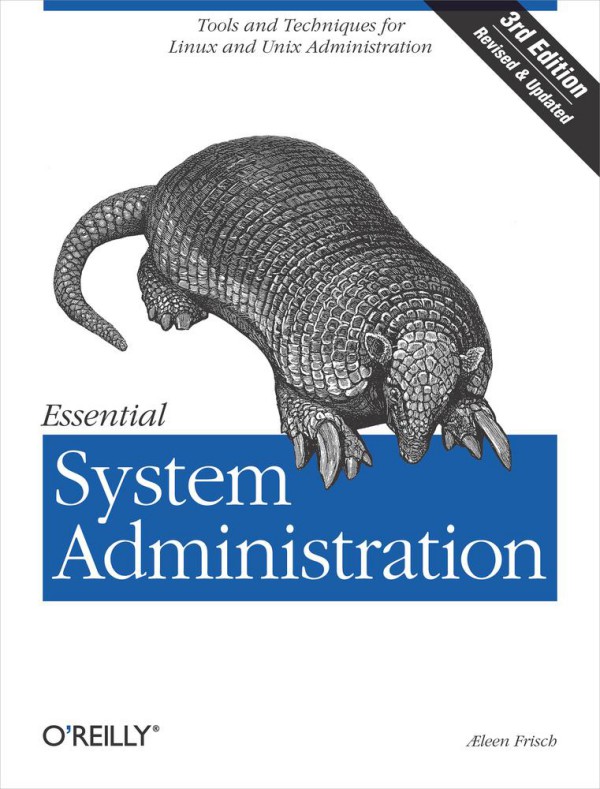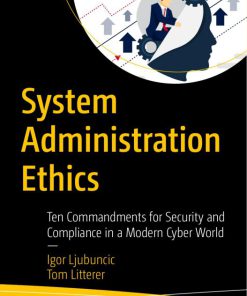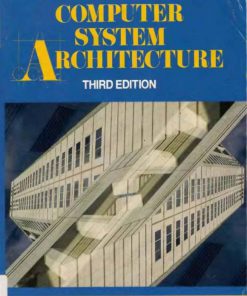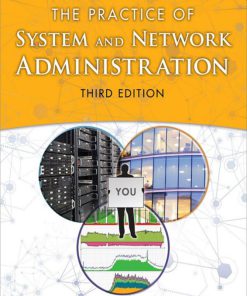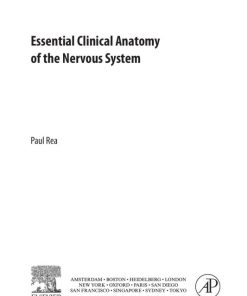Essential System Administration 3rd Edition by AEleen Frisch ISBN 0596003439 9780596003432
$50.00 Original price was: $50.00.$25.00Current price is: $25.00.
Authors:Æleen Frisch , Tags:1; Kindle10K; Reference:Computers , Author sort:Frisch, Æleen , Languages:Languages:eng , Published:Published:Feb 2009 , Publisher:O’Reilly Media , Comments:Comments:Whether you use a standalone Unix system, routinely provide administrative support for a larger shared system, or just want an understanding of basic administrative functions,Essential System Administrationis for you. This comprehensive and invaluable book combines the author’s years of practical experience with technical expertise to help you manage Unix systems as productively and painlessly as possible.
Essential System Administration 3rd Edition by AEleen Frisch – Ebook PDF Instant Download/Delivery. 0596003439, 9780596003432
Full download Essential System Administration 3rd Edition after payment
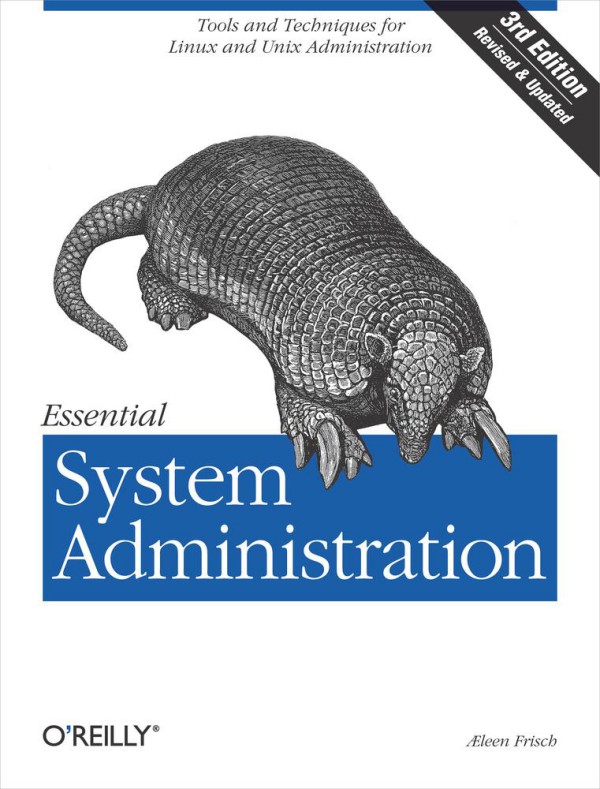
Product details:
ISBN 10: 0596003439
ISBN 13: 9780596003432
Author: AEleen Frisch
Essential System Administration,3rd Edition is the definitive guide for Unix system administration, covering all the fundamental and essential tasks required to run such divergent Unix systems as AIX, FreeBSD, HP-UX, Linux, Solaris, Tru64 and more. Essential System Administration provides a clear, concise, practical guide to the real-world issues that anyone responsible for a Unix system faces daily.The new edition of this indispensable reference has been fully updated for all the latest operating systems. Even more importantly, it has been extensively revised and expanded to consider the current system administrative topics that administrators need most. Essential System Administration,3rd Edition covers: DHCP, USB devices, the latest automation tools, SNMP and network management, LDAP, PAM, and recent security tools and techniques.Essential System Administration is comprehensive. But what has made this book the guide system administrators turn to over and over again is not just the sheer volume of valuable information it provides, but the clear, useful way the information is presented. It discusses the underlying higher-level concepts, but it also provides the details of the procedures needed to carry them out. It is not organized around the features of the Unix operating system, but around the various facets of a system administrator’s job. It describes all the usual administrative tools that Unix provides, but it also shows how to use them intelligently and efficiently.Whether you use a standalone Unix system, routinely provide administrative support for a larger shared system, or just want an understanding of basic administrative functions, Essential System Administration is for you. This comprehensive and invaluable book combines the author’s years of practical experience with technical expertise to help you manage Unix systems as productively and painlessly as possible.
Essential System Administration 3rd Table of contents:
Unix Versions Discussed in This Book
Audience
Organization
Chapter Descriptions
Conventions Used in This Book
Comments and Questions
Acknowledgments
Introduction to System Administration
Thinking About System Administration
Becoming Superuser
Controlling Access to the Superuser Account
Running a Single Command as root
sudo: Selective Access to Superuser Commands
Communicating with Users
Sending a Message
Sending a Message to All Users
The Message of the Day
Specifying the Pre-Login Message
About Menus and GUIs
Ups and Downs
AIX: SMIT and WSM
HP-UX: SAM
Solaris: admintool and Sun Management Console
Linux: Linuxconf
Red Hat Linux: redhat-config-*
SuSE Linux: YaST2
FreeBSD: sysinstall
Tru64: SysMan
Other Freely Available Administration Tools
The Ximian Setup Tools
VNC
Where Does the Time Go?
The Unix Way
Files
File Ownership
Displaying file ownership
Who owns new files?
Changing file ownership
File Protection
Types of file and directory access
Access classes
Setting file protection
Beyond the basics
Specifying numeric file modes
Specifying the default file mode
Special-purpose access modes
Save-text access on directories
Setgid access on directories
Numerical equivalents for special access modes
How to Recognize a File Access Problem
Mapping Files to Disks
Regular files
Directories
Special files: character and block device files
Links
Sockets
Named pipes
Using ls to identify file types
Processes
Interactive Processes
Batch Processes
Daemons
Process Attributes
The life cycle of a process
Setuid and setgid file access and process execution
The relationship between commands and files
Devices
An In-Depth Device Example: Disks
Fixed-disk special files
Special Files for Other Devices
Commands for listing the devices on a system
The AIX Object Data Manager
The Unix Filesystem Layout
The Root Directory
The /usr Directory
The /var Directory
Essential Administrative Tools and Techniques
Getting the Most from Common Commands
Getting Help
Changing the search order
Setting up man –k
Piping into grep and awk
Finding Files
Repeating Commands
Creating Several Directory Levels at Once
Duplicating an Entire Directory Tree
Comparing Directories
Deleting Pesky Files
Putting a Command in a Cage
Starting at the End
Be Creative
Essential Administrative Techniques
Periodic Program Execution: The cron Facility
crontab files
Adding crontab entries
cron log files
Using cron to automate system administration
cron security issues
System Messages
The syslog facility
Configuring syslog
Enhancements to syslog.conf
The logger utility
Hardware Error Messages
The AIX error log
Administering Log Files
Managing log file disk requirements
Monitoring log file contents
Managing Software Packages
HP-UX: Bundles, products, and subproducts
AIX: Apply versus commit
FreeBSD ports
Building Software Packages from Source Code
mtools: Using configure and accepting imperfections
bzip2: Converting Linux-based make procedures
jove: Configuration via make file settings
Internet software archives
Startup and Shutdown
About the Unix Boot Process
From Power On to Loading the Kernel
Booting to Multiuser Mode
Booting to Single-User Mode
Password protection for single-user mode
Firmware passwords
Starting a Manual Boot
AIX
FreeBSD
HP-UX
Linux
Tru64
Solaris
Booting from alternate media
Boot Activities in Detail
Boot messages
Saved boot log files
General considerations
Preliminaries
Preparing filesystems
Checking and mounting the root filesystem
Preparing other local filesystems
Saving a crash dump
Starting paging
Security-related activities
Checking disk quotas
Starting servers and initializing local subsystems
Connecting to the network
Housekeeping activities
Allowing users onto the system
Initialization Files and Boot Scripts
Initialization Files Under FreeBSD
Initialization Files on System V Systems
System V run levels
Using the telinit command to change run levels
Initialization files overview
The init configuration file
The rcn initialization scripts
Boot script configuration files
File location summary
Solaris initialization scripts
Tru64 initialization scripts
Linux initialization scripts
AIX: Making System V work like BSD
Customizing the Boot Process
Adding to the boot scripts
Eliminating certain boot-time activities
Modifying standard scripts
Guidelines for writing initialization scripts
Shutting Down a Unix System
The System V shutdown Command
HP-UX shutdown security
The BSD-Style shutdown Command
The Linux shutdown Command
Ensuring Disk Accuracy with the sync Command
Aborting a Shutdown
Troubleshooting: Handling Crashes and Boot Failures
Power-Failure Scripts
When the System Won’t Boot
Bad or flaky hardware
Unreadable filesystems on working disks
Damage to non-filesystem areas of a disk
Incompatible hardware
System configuration errors
TCP/IP Networking
Understanding TCP/IP Networking
Media and Topologies
Identifying network adapters
Protocols and Layers
Ports, Services, and Daemons
Administrative Commands
A Sample TCP/IP Conversation
Names and Addresses
Subnets and Supernets
Introducing IPv6 host addresses
Connecting Network Segments
Adding a New Network Host
Configuring the Network Interface with ifconfig
Ethernet interface names
Other uses of ifconfig
ifconfig on Solaris systems
Interface configuration at boot time
Dynamic IP Address Assignment with DHCP
AIX
FreeBSD
HP-UX
Linux
Solaris
Tru64
Name Resolution Options
The /etc/hosts file
Configuring a DNS client
The name service switch file
Routing Options
AIX
FreeBSD
HP-UX
Linux
Solaris
Tru64
Network Testing and Troubleshooting
Managing Users and Groups
Unix Users and Groups
The Password File, /etc/passwd
The Shadow Password File, /etc/shadow
The FreeBSD /etc/ master.passwd file
The protected password database under HP-UX and Tru64
The Group File, /etc/group
User-private groups
Dynamic Group Memberships
The Linux group shadow file, /etc/gshadow
The HP-UX /etc/logingroup file
AIX group sets
User Account Database File Protections
Standard Unix Users and Groups
Using Groups Effectively
Managing User Accounts
Adding a New User Account
Defining a New User Account
Assigning a Shell
Captive accounts
Assigning a Password
Creating a Home Directory
User Environment Initialization Files
Sample login initialization files
Sample shell initialization files
The AIX /etc/security/environ file
Desktop environment initialization files
Systemwide initialization files
Setting File Ownership
Adding the User to Other System Facilities
Specifying Other User Account Controls
AIX user account controls
FreeBSD user account controls
Linux user account controls
Solaris login process settings
Specifying login time restrictions under HP-UX and Tru64
Testing the New Account
Using su to re-create a user’s environment
Disabling and Removing User Accounts
Removing a user account
Administrative Tools for Managing User Accounts
Command-Line Utilities
The useradd command: HP-UX, Linux, Solaris, and Tru64
Commands for managing groups
The Linux gpasswd command
The FreeBSD user account utilities
The AIX user account utilities
Graphical User Account Managers
Managing users with SMIT under AIX
Managing users with SAM under HP-UX
Linux graphical user managers
Solaris GUI tools for managing user accounts
Managing user accounts with dxaccounts under Tru64
Automation You Have to Do Yourself
Administering User Passwords
Selecting Effective Passwords
Forcing a password change
Managing dozens of passwords
Educating Users About Selecting Effective Passwords
Password advice in the age of the Internet
Setting Password Restrictions
Password aging
Password triviality checks
The freely available npasswd command
Password history lists
Password settings default values
Testing User Passwords for Weaknesses
John the Ripper
Using Crack to find poorly chosen passwords
How well do they do?
User Authentication with PAM
PAM Defaults
PAM Modules Under Linux
Checking passwords at selection time
Specifying allowed times and locations for system access
MD5 passwords
PAM Modules Provided by Other Unix Systems
More Complex PAM Configuration
LDAP: Using a Directory Service for User Authentication
About LDAP
LDAP Directories
About schemas
Installing and Configuring OpenLDAP: An Overview
More about LDAP searching
Using OpenLDAP for User Authentication
Select an appropriate schema
Convert existing user account data
Specify the name service search order
Configure directory access control
OpenLDAP access control
Securing OpenLDAP Authentication
Wither NIS?
Security
Prelude: What’s Wrong with This Picture?
Thinking About Security
Security Policies and Plans
Security policies
Security plans
Unix Lines of Defense
Physical security
Firewalls and network filters
Passwords
Encrypting data
Backups
Version-Specific Security Facilities
User Authentication Revisited
Smart Cards
One-Time Passwords
Solaris and HP-UX Dialup Passwords
AIX Secondary Authentication Programs
Better Network Authentication: Kerberos
Protecting Files and the Filesystem
Search Path Issues
Small Mistakes Compound into Large Holes
The setuid and setgid Access Modes
Writing setuid/setgid programs
Access Control Lists
Introducing access control lists
Manipulating AIX ACLs
HP-UX ACLs
POSIX access control lists: Linux, Solaris, and Tru64
Encryption
The crypt command
Public key encryption: PGP and GnuPG
Selecting passphrases
Role-Based Access Control
AIX Roles
Solaris Role-Based Access Control
Network Security
Establishing Trust
The implications of trust
The Secure Shell
Securing Network Daemons
TCP Wrappers: Better inetd access control and logging
xinetd
Disable what you don’t need
Port Scanning
Defending the Border: Firewalls and Packet Filtering
Hardening Unix Systems
Plan Before Acting
Secure the Physical System
Install the Operating System
Secure Local Filesystems
Securing Services
Restrict root Access
Configure User Authentication and Account Defaults
Set up Remote Authentication
Install and Configure Ongoing Monitoring
Backup
Other Activities
Detecting Problems
Password File Issues
Monitoring the Filesystem
Checking file ownership and protection
Looking for setuid and setgid files
Checking modification dates and inode numbers
Computing checksums
Run fsck occasionally
Automating Security Monitoring
Trusted computing base checking
System integrity checking with Tripwire
Vulnerability scanning
Scanning for network vulnerabilities
What to Do if You Find a Problem
Investigating System Activity
Monitoring unsuccessful login attempts
su log files
History on the root account
Tracking user activities
Event-auditing systems
Intruders Can Read
Managing Network Services
Managing DNS Servers
Zones
Name Server Types
About BIND
Configuring named
The master configuration file: named.conf
The root hints file
Zone files
Common mistakes to avoid
Using subdomains
Forwarders
Slave name server notifications
Dynamic updates
Incremental zone transfers
Access control
Securing DNS communications
BIND 9 views
Securing the named process
Configuring logging
Name Server Maintenance and Troubleshooting
Controlling the named server process
Using the nslookup and dig utilities
Routing Daemons
Routing Concepts and Protocols
Configuring routed
Configuring gated
Configuring a DHCP Server
AIX
ISC DHCP: FreeBSD and Linux
HP-UX
Solaris
Tru64
Time Synchronization with NTP
How NTP Works
Setting Up NTP
Enabling ntpd under FreeBSD
A Simple Authentic Time Option
Managing Network Daemons under AIX
Monitoring the Network
Standard Networking Utilities
Packet Sniffers
The Solaris snoop command
Packet collecting under AIX and HP-UX
The Simple Network Management Protocol
SNMP concepts and constructs
SNMP implementations
Net-SNMP client utilities
Configuring SNMP agents
SNMP and security
Network Management Packages
Proactive network monitoring
Identifying trends over time
Electronic Mail
About Electronic Mail
Mail Addressing and Delivery
DNS MX records
Mail aliases
Mail forwarding
Putting it all together
Electronic Mail Policies
Configuring User Mail Programs
Automated Email Message Encryption
Configuring Access Agents
Setting Up User Agents to Use POP and IMAP
Configuring the Transport Agent
sendmail
Configuring sendmail
Getting started: A sample mail client configuration
Building sendmail.cf
Configuring the mail hub
Selecting mailers
Some client and mail hub variations
More addressing options
Virtual hosting
The services switch file
Spam suppression
Public blacklists and the access database
sendmail security
Monitoring ongoing operation
Performance
Debugging techniques
Macro summary
Postfix
Installing Postfix
Configuring Postfix
Access control and spam suppression
Postfix security
Monitoring and performance
Debugging
Retrieving Mail Messages
Mail Filtering with procmail
Configuring procmail
Other procmail disposition options
Using procmail to discard spam
Using procmail for security scanning
Debugging procmail
Additional information
A Few Final Tools
Filesystems and Disks
Filesystem Types
About Unix Filesystems: Moments from History
Journaled filesystems
BSD soft updates
Default Local Filesystems
Managing Filesystems
Mounting and Dismounting Filesystems
Disk Special File Naming Conventions
The mount and umount Commands
Figuring Out Who’s Using a File
The Filesystem Configuration File
Solaris: /etc/vfstab
AIX: /etc/filesystems and /etc/swapspaces
Automatic Filesystem Mounting
Using fsck to Validate a Filesystem
After fsck
From Disks to Filesystems
Defining Disk Partitions
Adding Disks
Preparing and connecting the disk
Making special files
FreeBSD
Linux
Solaris
AIX, HP-UX, and Tru64
Remaking an existing filesystem
Logical Volume Managers
Disks, volume groups, and logical volumes
Disk striping
Disk mirroring and RAID
AIX
HP-UX
Tru64
Solaris
Linux
FreeBSD
Floppy Disks
Floppy disk special files
Using DOS disks on Unix systems
The Mtools utilities
Stupid DOS partition tricks
CD-ROM Devices
CD-ROM drives under AIX
The Solaris media-handling daemon
Sharing Filesystems
NFS
Mounting remote directories
Exporting local filesystems
The NFS Automounter
Samba
Samba authentication
Backup and Restore
Planning for Disasters and Everyday Needs
Backup Capacity Planning
Backup Strategies
Unattended backups
Data verification
Storing backup media
Off-site and long-term storage
Backup Media
Magnetic tape
Magneto-optical disks
CDs and DVDs
Removable disks: Zip and Jaz
Floppy disks
Hard disks
Stackers, jukeboxes, and similar devices
Media Lifetime
Comparing Backup Media
Tape Special Files
AIX tape device attributes
Backing Up Files and Filesystems
When tar or cpio Is Enough
The tar command
The cpio command
Incremental backups with tar and cpio
pax: Detente between tar and cpio
Backing Up Individual Filesystems with dump
The HP-UX fbackup utility
Related Tape Utilities
Data copying and conversion with dd
Tape manipulation with mt
Restoring Files from Backups
Restores from tar and cpio Archives
Restoring from dump Archives
The restore utility’s interactive mode
The HP-UX frecover utility
Moving Data Between Systems
Making Table of Contents Files
Network Backup Systems
Remote Backups and Restores
The Amanda Facility
About Amanda
How Amanda works
Doing the math
Configuring Amanda
Amanda reports and logs
Restoring files from an Amanda backup
Commercial Backup Packages
Backing Up and Restoring the System Filesystems
AIX: mksysb and savevg
Restoring individual files from a mksysb tape
Saving and restoring AIX user volume groups
FreeBSD
HP-UX: make_recovery
Linux
Solaris
Tru64: btcreate
Serial Lines and Devices
About Serial Lines
Device Files for Serial Lines
The tty Command
Specifying Terminal Characteristics
termcap and terminfo
termcap entries
terminfo entries
Modifying entries
The tset Command
The stty Command
Adding a New Serial Device
Making the Physical Connection
Hardware handshaking and flow control
Terminal Line Configuration
FreeBSD configuration files
System V configuration files
Starting the Terminal Line
Terminal Handling Under Solaris
Structure of the Service Access Facility
Port monitors
Creating port monitors with pmadm
The ttydefs file
Using admintool to configure serial lines
Troubleshooting Terminal Problems
Controlling Access to Serial Lines
HP-UX and Tru64 Terminal Line Attributes
The HylaFAX Fax Service
Sending Faxes
Managing Faxes
HylaFAX Configuration Files
Controlling Access to HylaFAX
USB Devices
FreeBSD USB Support
Linux USB Support
Solaris USB Support
Printers and the Spooling Subsystem
The BSD Spooling Facility
User Commands
Manipulating Print Jobs
Managing Queues
The Spooling Daemon
Configuring Queues: The printcap File
Spooling directories
Restricting printer access
A filter program
Remote Printing
Adding a New Printer
LPD Variations
FreeBSD
Tru64
Linux
System V Printing
User Commands
The system default printer
Device classes
Getting status information
Manipulating Individual Print Requests
Managing Queues
Starting and Stopping the Print Service
Managing Printers and Destination Classes
Defining or modifying a printer
Deleting printers
Managing device classes
In-queue priorities
Printer interface programs
Remote Printing
HP-UX remote printing
Solaris remote printing
Adding a New Printer
System V Spooling System Variations
Solaris: Additional configuration files
Solaris: Controlling printer access
Solaris: Forms and filters
HP-UX: Altering pending print jobs
HP-UX: Analyzing printer usage
Graphical administration tools
The AIX Spooling Facility
Manipulating Print Jobs
Job numbers
The default print queue under AIX
Displaying job and queue status information
Deleting print jobs
Moving jobs between queues
Suspending print jobs
Print job priorities
Managing Queues and Devices
The qdaemon Server Process
Configuring Queues: The /etc/qconfig File
Creating and modifying print queues
Remote Printing
Adding a New Printer
Using the Queueing System as a Batch Service
Troubleshooting Printers
Sharing Printers with Windows Systems
Printing to a Windows Printer from a Unix System
Accepting Incoming Windows Print Jobs via Samba
Creating queues for the Samba printers under Windows
LPRng
Enhancements to the lpc Command
Print classes and job priorities
Configuring LPRng
Separate client and server entries
Using a common printcap file for many hosts
Special-purpose queues
Filters
Other printcap entry options
Global Print Spooler Settings
Printer Access Control
Other LPRng capabilities
CUPS
Printer Administration
CUPS configuration files
Access control and authentication
Font Management Under X
Font Basics
Managing Fonts under X
Adding Fonts to X
Printing support
Handling TrueType Fonts
Automating Administrative Tasks
Creating Effective Shell Scripts
Password File Security
Monitoring Disk Usage
Root Filesystem Backups and System Snapshots
A Few More Tricks
Testing and Debugging Scripts
Perl: An Alternate Administrative Language
A Quick Introduction
A Walking Tour of Perl
Perl Reports
Graphical Interfaces with Perl
Expect: Automating Interactive Programs
A First Example: Testing User Environments
A Timed Prompt
Repeating a Command Over and Over
Automating Configuration File Distribution
Keep Trying Until It Works
When Only C Will Do
Automating Complex Configuration Tasks with Cfengine
About Cfengine
Actions
Classes
Configuring cfservd
Running Cfengine
Stem: Simplified Creation of Client-Server Applications
Adding Local man Pages
Managing System Resources
Thinking About System Performance
The Tuning Process
1. Define the problem in as much detail as you can.
2. Determine what’s causing the problem.
3. Formulate explicit performance improvement goals.
4. Design and implement modifications to the system and applications to achieve those goals.
5. Monitor the system to determine how well the changes worked.
6. Return to the first step and begin again.
Some Tuning Caveats
Monitoring and Controlling Processes
The ps Command
Other Process Listing Utilities
The /proc Filesystem
Kernel Idle Processes
Process Resource Limits
Process Resource Limits Under AIX
Signaling and Killing Processes
Killing multiple processes with killall
Processes that won’t die
Pausing and restarting processes
Managing CPU Resources
Nice Numbers and Process Priorities
Monitoring CPU Usage
Recognizing a CPU shortage
Changing a Process’s Nice Number
renice under AIX, HP-UX, and Tru64
Changing process priorities under Solaris
Setting a user’s default nice numbers under Tru64
Configuring the System Scheduler
The AIX scheduler
The Solaris scheduler
Tru64
Unix Batch-Processing Facilities
Managing Memory
Monitoring Memory Use and Paging Activity
Determining the amount of physical memory
Monitoring memory use
Recognizing memory problems
The filesystem cache
Configuring the Virtual Memory Manager
AIX
FreeBSD
HP-UX
Linux
Solaris
Tru64
Managing Paging Space
How much paging space?
Listing paging areas
Activating paging areas
Creating new paging areas
Filesystem paging
Linux and HP-UX paging space priorities
Removing paging areas
Disk I/O Performance Issues
Monitoring Disk I/O Performance
Getting the Most From the Disk Subsystem
Disk hardware
Distributing the data among the available disks
Data placement on disk
Tuning Disk I/O Performance
Sequential read-ahead
Disk I/O pacing
Monitoring and Managing Disk Space Usage
Where Did It All Go?
Handling Disk Shortage Problems
Using find to locate or remove wasted space
Limiting the growth of log files
Controlling Disk Usage with Disk Quotas
Preparing filesystems for quotas
Setting users’ quota limits
Setting the soft limit expiration period
Enabling quota checking
Quota consistency checking
Disk quota reports
Group-based quotas (AIX, FreeBSD, Tru64 and Linux)
Network Performance
Basic Network Performance Monitoring
General TCP/IP Network Performance Principles
Two TCP parameters
DNS Performance
NFS Performance
NFS Version 3 performance improvements
NFS performance principles
Configuring and Building Kernels
FreeBSD and Tru64
Changing FreeBSD Kernel Parameters
FreeBSD Kernel Modules
Installing the FreeBSD Boot Loader
Tru64 Dynamic Kernel Configuration
HP-UX
Linux
Using lilo
Using a graphical message screen
lilo and Windows
More complex booting scenarios
lilo’s -r option
The boot.message file
The Grub Boot Loader
Booting a Linux System with syslinux
Restoring the DOS Master Boot Program
Booting Alpha Linux Systems
Linux Loadable Modules
Solaris
AIX System Parameters
Accounting
Standard Accounting Files
BSD-Style Accounting: FreeBSD, Linux, and AIX
Enabling and Disabling Accounting
Merging Accounting Records into the Summary Files
After a Crash
Image-Based Resource Use Reporting: sa
Connect Time Reporting: ac
System V–Style Accounting: AIX, HP-UX, and Solaris
Setting Up Accounting
Accounting Reports
Solaris Project-Based Extended Accounting
The upacct Package
Printing Accounting
Printer Accounting Under LPRng
The Profession of System Administration
SAGE: The System Administrators Guild
Administrative Virtues
Administrative Shell Programming
Basic Syntax
I/O Redirection
The dot Command
Return Codes and the exit Command
Compound Commands
Command Substitution
Argument Symbols and Other $ Abbreviations
Variable Substitution
bash variable substitution extensions
Variable Double Dereferencing
The if Statement
The test Command (a.k.a. [ )
Other Control Structures
The while and until Commands
The case Command
The for Command
The bash arithmetic for loop
The Null Command
Getting Input: The read Command
The bash select command
Other Useful Commands
People also search for Essential System Administration 3rd:
essential system administration
oreillys essential system administration
essential system administration 3rd edition
essential system administration pdf
essential system administration tools in linux

